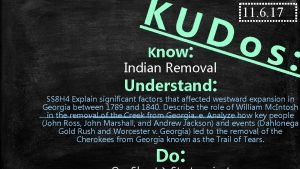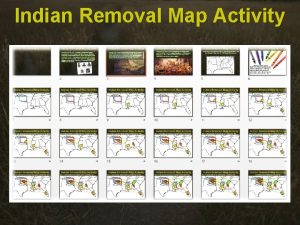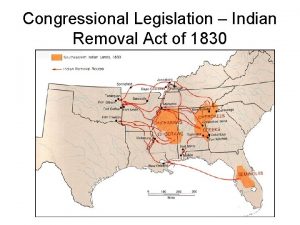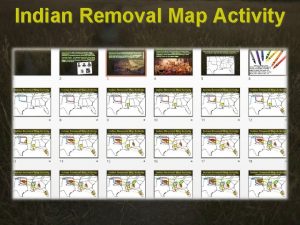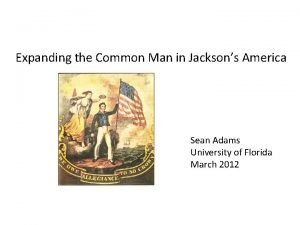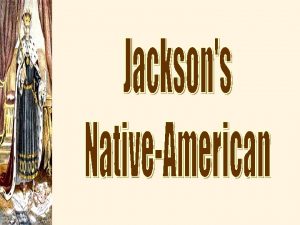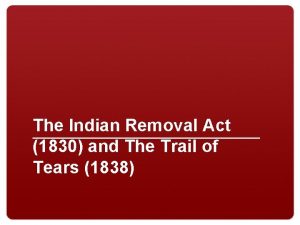Indian Removal Act 1830 Andrew Jacksons First Annual












- Slides: 12

Indian Removal Act 1830

Andrew Jackson’s First Annual Message to Congress (1829) While denying the sovereign right to Native American tribes within state limits… Jackson lays out his policy of voluntary removal to areas west of the Mississippi. 2

Indian Removal Act of 1830 Congress passed act that removed all Native American tribes living east of the Mississippi to west of the Mississippi (Oklahoma, Indian Territory)

Worcester v. Georgia (1832) The Supreme Court ruled the State of Georgia had no power to pass any law affecting the Cherokee Nation. Worcester, in principle, guaranteed the sovereign claims of the Cherokee nation and the lands within their boundaries. Jackson remarked, “The Chief Justice has made his decision, now let him enforce it. ” The social principles outlined in Worcester never became a political reality because of later developments. Aka Jackson (and Georgia) ignored the ruling, but nothing was really done. 4

The Indian Removal Act (1830) The Indian Removal Act set the stage of Native American affairs during Jackson’s presidency. Removal of eastern tribes to lands west of the Mississippi was an Indian policy. This included the Trail of Tears. Government provides funds to negotiate treaty 90 treaties are signed Some tribes resisted 5

The Treaty of New Echota Signed by Ridge and members of the Treaty Party in 1835, gave Jackson the legal document remove the First Americans. Ratification of the treaty by the U. S. Senate sealed the fate of the Cherokee. The few who spoke out against the ratification was Daniel Webster and Henry Clay.

Osceola Resists Seminoles in Florida led by Chief Osceola Helped by escaped slaves Takes 7 years to put down 2 nd Seminole War Cost of 20 million dollars


Trail of Tears Georgia militia brutally rounds up 17, 000 Destination: Oklahoma 800 miles – 6 months: boat, RR, foot ¼ Cherokee died along the way New land far inferior

The 'Trail of Tears' In 1838, General Winfield Scott arrived in Georgia with 7, 000 men to enforce the Treaty of New Echota, which relocated the Cherokees to what is now Oklahoma. Between 3, 000 -5, 000 Cherokees died en route, this became known as the 'Trail of Tears. ' 10


Five Civilized Tribes Tribe How they resisted How they were removed Choctaw No resistance, were not given enough food or supplies voluntarily Cherokee Adopted the contemporary culture of the white. sued the U. S. Supreme Court for right to stay on their lands. 7, 000 men to enforce the Treaty, 3, 000 -5, 000 died , known as the 'Trail of Tears. ' Seminole Refused to leave their lands 4, 000 were removes, in Florida, leading to hundreds died, US officials the Second Seminole War. gave up the fight. Creek Stealing livestock and crops Federal troops captured from settlers, committed 14, 500, moved them in arson and murder for their chains to Indian Territory. brutal treatment. Chickasaw seen removal as inevitable, and had not resisted. Signed Treaty for better suppiles. were forced to pay the Choctaws for the right to live on part of western allotment.
 Indian removal act
Indian removal act Indian removal act map activity
Indian removal act map activity Indian removal act of 1830
Indian removal act of 1830 Indian removal act of 1830
Indian removal act of 1830 Congressional act of 1830
Congressional act of 1830 Indian removal map activity
Indian removal map activity Results of jacksons bank war
Results of jacksons bank war U loop canine retractor
U loop canine retractor Jackson's compression test
Jackson's compression test Jacksons of kingfisher
Jacksons of kingfisher Liberty leading the people, 1830
Liberty leading the people, 1830 Ensayos constitucionales de chile entre 1823 y 1830
Ensayos constitucionales de chile entre 1823 y 1830 Map of us in 1830
Map of us in 1830
